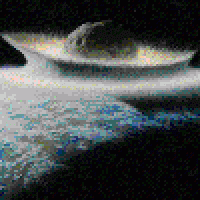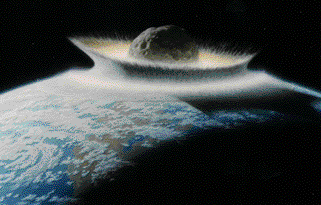
Flyby asteroid

Will it happen? Image by Donald E. Davis, courtesy NASA.
On July 3rd an asteroid skimmed the Earth and was one of only 782 known potential hazards to come this close. The asteroid, named 2004 XP14, is approximately 800 metres wide and travelling at 17 kilometres per second. This is enough to wipe out a country the size of Belgium and cause the sun to be blocked out by a blanket of dust in surrounding areas for many months. The asteroid came closest to the Earth at 04:44 GMT above North America; at this point it was 432,820km from the Earth. This may seem a lot, but comparing that to the average Earth-Moon distance of 385,000km you can see why it was a hazard. In fact, the distance from the Asteroid to the Earth is only 1.1 times the distance from the Earth to the Moon, meaning that it has a 1.1 Lunar Distance (LD).
This asteroid was discovered in December 2004 by the Lincoln Near Earth Asteroid Research (Linear) Project funded by NASA. This organisation watches the sky for objects that could be dangerous. They calculate the size of these objects by bouncing high frequency radio waves off their surfaces. The reflected waves are then analysed and the resulting data gives information about the object's size, velocity and distance. The distance is calculated from the time delay between the radar beam hitting the object and coming back to be detected by an antenna. The equation that is used here is Distance = Speed x Time. The velocity of the asteroid can be detected because for a moving object the frequency of the reflected wave will be different from the frequency of the initial wave, due to a phenomenon called the Doppler Effect (see Plus article Doppler detectives).
The asteroid was not visible to the naked eye, though it could be observed with a decent amateur telescope. Asteroid 2004 XP14 is a member of a class of asteroids known as Apollos, which have Earth-crossing orbits. There are now 1,989 known Apollos. Predictions can be made about potential collisions, but whether or not these are accurate is a different matter. However, there is no need to lose any sleep: asteroids that hit the Earth and cause a similar effect to what supposedly wiped out the dinosaurs are extremely rare, probably occurring once every 300 million years. Smaller asteroids hit the Earth on average once every 156 years, but these do not pose a great threat and should only cause local damage.
The next big event for astronomers will be Friday April 13th 2029. Scientists predict that the asteroid Apophis will be coming only 32,000 kilometres from the Earth, which is close enough to hit a weather satellite and even be visible without a telescope.
As of Asteroid 2004 XP14, it is now heading away from the Earth, and even though it will come near to the Earth 10 more times this century, it will not pose a threat. It may come closer in the future, even cause a collision, but the chance of this occurring is relatively slim. Even if it did crash into Earth, the effects would be regional and there would be plenty of time for warning. The asteroid would have to be about twice its size to threaten civilization.